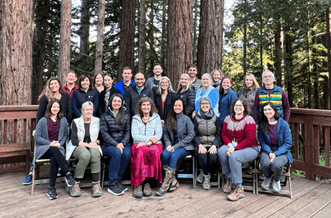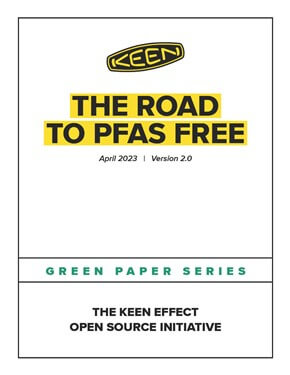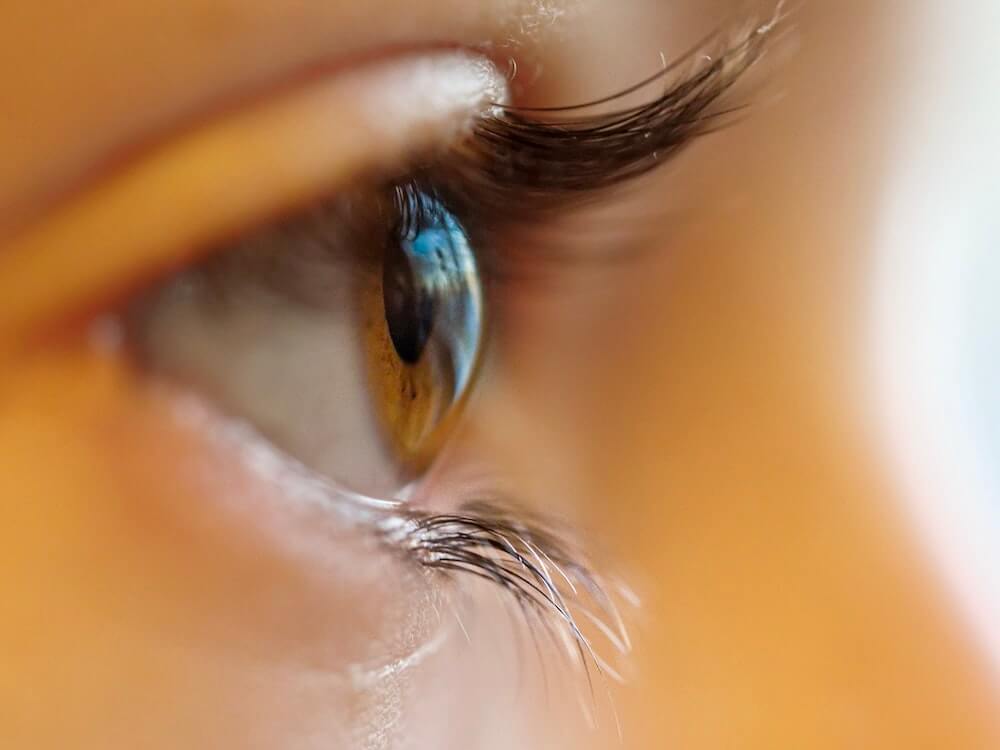May 2023: Over Being Over-Disinfected?
In this edition:
- Popular COVID Disinfectants Harmful and Often Unnecessary
- Restricted Flame Retardants in Baby Toys & More
- Outdoor Brands Phase Out PFAS Ahead of State Bans
- PFAS on Your Eyeballs?
- Green Science Policy Institute in the News
- CALENDAR
I hope you are having a happy and healthy spring. I’m recently back from our Institute’s Tenth Anniversary Six Classes Toxics Reduction Retreat in the Santa Cruz mountains. During these inspirational three-day gatherings leaders from business, academia, government, and NGOs with passion to reduce toxics in our products and planet have come together to share their challenges and successes.
Beginning in 2013, retreat participants have developed innovative joint projects to limit the use of chemical classes of concern. Past participants have designed new analytic techniques to measure PFAS, written influential papers to reduce chemical harm, and manufactured and sold healthier toxic-free products. Best of all, our focus since the first retreat – the class concept – has contributed to reducing chemical harm worldwide. This year we focused on big ideas towards a healthier world such as reducing toxic pollution to join stopping climate change and plastic pollution as critical sustainability goals.
I am just back from visiting New York City, where I was honored to give a talk on stopping the use of PFAS at the Sustainable Cosmetics Summit, attended by senior executives in the beauty industry. Many had not previously known that PFAS in personal care products have been banned in several U.S. states or that these harmful chemicals are often not necessary. Some cosmetics manufacturers already have stopped the use of all PFAS and reported that this was easier than they had expected.
More good news: Following on from California and New York legislation banning PFAS in textiles, the outdoor industry is stopping the use of these chemicals. You can read below how KEEN shoes has been leading the industry away from PFAS and other of our six chemical classes of concern. You can also check out my Forward to their updated KEEN Green Paper here which shares with other brands what KEEN learned about stopping the use of PFAS.
Now as more industries are taking on the challenge of phasing out PFAS, a less well-known class of chemicals is beginning to get the attention it deserves. Chlorinated paraffins are harmful and highly persistent substances which can build up in our bodies, food webs, and environment.
Recently, our colleagues at the University of Toronto detected chlorinated paraffins in more than 85 percent of consumer products they tested, including headphones, plastic toys, clothing, personal care products, and indoor paints purchased in Canada.
These findings were shocking since these harmful chemicals have been banned in Canada for a decade. Also, these uses can easily lead to human exposure through direct hand contact, mouthing of products by young children, and through contaminated dust.
Since the tested Canadian products were largely manufactured for an international market, chlorinated paraffins are also likely found in products in the U.S., Europe, and beyond. Like organohalogen flame retardants, many of their uses are likely unnecessary and should be stopped. “Given their potential for harm, the fact that most uses are not necessary, and that Canada has banned their use, it’s astonishing that so many products still contain them,” I told the Toronto Star. This study was also covered by Global News, Yahoo, Chemical Watch, and more.
The overuse of antimicrobials is also getting more attention with this week’s publication of our Institute-led peer-reviewed paper (with authors from 14 universities, four government agencies, and several NGOs) about quaternary ammonium compounds. QACs or quats are a class of antimicrobial chemicals that are overused–especially since the COVID-19 pandemic. Our team reviewed the science and found that the harms of QACs (links to respiratory/reproductive problems, contributions to antimicrobial resistance, etc.) may outweigh their benefits. Learn more in the blurb below.
For those of you in the San Francisco Bay Area, please join me for the 40th annual Berkeley Himalayan Fair at Live Oak Park May 20th and 21st. More info is in the calendar below. I hope to see you there.
With best regards for an enjoyable spring,
Arlene and the Green Science Policy Team
Popular COVID Disinfectants Harmful and Often Unnecessary
by Rebecca Fuoco
The COVID-19 pandemic has boosted the unnecessary use of harmful antimicrobial chemicals, warns a new paper by more than two dozen scientists (including our Institute’s Anna Soehl, Carol Kwiatkowski, and Arlene Blum).
Their critical review details how quaternary ammonium compounds (QACs) are increasingly marketed and used in home, healthcare, education, and workplace settings despite the availability of safer alternatives and in some cases limited evidence of reduced disease transmission.
Zealous spraying and wiping of surfaces with QACs continues in schools and workplaces, even as the pandemic recedes. When disinfection is needed, safer products are available.
What’s at stake? Human studies have found associations between some QACs and asthma, dermatitis, and inflammation. Laboratory animal studies also raise concerns about potential links to infertility, birth defects, and more. Further, evidence dating back to the 1950s suggests that QACs contribute to antimicrobial resistance, making certain bacteria species resistant both to QACs themselves and to critical antibiotics.
Benzalkonium chloride is a common QAC and others can be identified on ingredient labels with names that end in “-onium chloride” or similar. However, disclosure and regulation of QACs varies widely. For example, pesticide labels are required to list QACs but paint labels are not. Most QACs are not regulated at all, nor are they comprehensively screened for health hazards. The scientists recommend eliminating uses of QACs that are either unnecessary or where their effectiveness has not been demonstrated. For example, disinfection with QACs often has no benefit over cleaning with plain soap and water. Other recommendations include requiring full disclosure of QACs in all products and closely monitoring their levels in people and the environment.
“Reducing the use of QACs won’t spread COVID-19,” says Carol Kwiatkowski from our Institute. “In fact, it will make our homes, classrooms, offices, and other shared spaces healthier.”
Restricted Flame Retardants in Baby Toys & More
By Lydia Jahl
One of the most sobering aspects of keeping up with environmental health research is learning when harmful chemicals are used in consumer products. On the other hand, this knowledge can empower consumers to make smarter purchasing decisions and prompt policymakers to act. Unfortunately, this progression of research → communication → action falls through when chemicals that are already banned still end up in products.
That is exactly what occurred when researchers detected chlorinated paraffin chemicals in 84 out of 96 tested Canadian products. These chemicals, used as flame retardants, plasticizers, and more, are persistent, bioaccumulative, and toxic.
Some of the highest levels of chlorinated paraffins were found in plastic baby toys–especially concerning because toddlers often put toys in their mouths and eat with their hands. High concentrations were also found in electronics, such as the outer plastic sheaths of a computer wire and a headphone wire – remember not to mindlessly chew on your headphone wires, and wash your hands before eating to reduce your exposure chlorinated paraffins and other harmful chemicals.
The presence of these chemicals in consumer products despite current restrictions is unsettling to the point that the authors called for “concerted and coordinated international efforts to stem their production and international trade.” CPs are less-studied than legacy flame retardants like PBDEs, but a few recent papers have confirmed their widespread contamination with detections in Japanese children’s toys, tea & tea packaging, instant noodles, and recycled car tire products. Here at the Institute, we will continue to examine chlorinated paraffins as well as other less-studied flame retardants like PolyFR. And as always, we encourage our readers to vote with your dollar by purchasing healthier, plastic-free products and vote for candidates who support health and environment.
Outdoor Brands Phase Out PFAS Ahead of State Bans
By Tatum McConnell for Environmental Health News
The outdoor footwear company KEEN made a discovery about their shoes in 2014: they were rife with stain- and water-resistant chemicals known to harm human health called PFAS, also known as “forever chemicals.”
Laces, buckles, interior textiles and more were receiving a PFAS treatment before becoming part of a sandal or hiking boot.
“PFAS were being applied to styles that were meant to go in the water, and a water shoe doesn't need to be waterproof,” Lauren Hood, KEEN sustainability manager, told Environmental Health News (EHN).
The company started by asking suppliers to stop using unnecessary PFAS, which removed about 65% of this type of chemicals in their products. It took four years for KEEN to phase out PFAS in all products, through finding and testing chemical water-proofing alternatives.
Now apparel companies will need to follow KEEN’s example to comply with upcoming bans on PFAS in consumer products, including outdoor clothing, passed in at least three U.S. states. With varying timelines, the bans apply to all types of PFAS chemicals (researchers have documented more than 9,000), and cover industries specified in each state’s bill, such as food packaging or textiles...
PFAS on Your Eyeballs?
By Ariana Spentzos
More bad news on harmful chemicals in everyday products: The contact lenses many of us wear every day contain organic fluorine—which is likely PFAS.
A joint consumer study by the blog Mamavation and Environmental Health News tested eighteen different kinds of contacts and detected organic fluorine in all of them. Some of the brands tested had very high levels of organic fluorine—up to 20,000 ppm—whereas intentional use is often any level above 20-100 ppm.
The likely source of PFAS in contact lenses is from fluorosilicone polymers that give the desired oxygen-permeability and wetting properties that allow for long-term wear. Large molecule fluoropolymers are considered a lower direct risk to human health compared to smaller PFAS such as PFOA or PFOS, but the health implications of PFAS in contact lenses are not known. Considering the direct exposure, sensitive nature of the eyes, and high detection levels caution is prudent and further testing to validate these results is needed.
The detection of PFAS in contact lenses adds a further complicating dimension to their disposal and waste. Contact lenses are already known to break down into microplastics and a study found that 15-20% of people simply flush their lenses down the drain leading to about 50,000 pounds of plastic lens waste ending up in U.S. wastewater annually. Such improper disposal could contribute to environmental PFAS contamination.
Fortunately, the levels detected in some brands were relatively low, perhaps opening the door for greater understanding of whether or not fluoropolymers are essential in contact lenses and the development of more PFAS-free alternatives.
Green Science Policy Institute in the News

Below are recent news articles, blogs, podcasts, newsletters, and more that have featured our Institute’s work and expertise.
- The Guardian covered our recent study with the finding that the large PFAS used in food packaging break down into smaller PFAS which could migrate into food or air.
- Arlene did a radio interview with Alaska Public Media about mountaineering and science.
- A new study exposing the enormity of hazardous chemicals used across many product categories calls their use into question, Carol explained to Environmental Health News. “Prioritization is hard, the authors have provided valuable information for regulatory agencies to act on.”
- Forbes cited our recent study finding that PFAS finishes have limited to no effectiveness in preventing furniture stains.
- “Only a small fraction of the thousands of PFAS have been tested for toxicity, but we know that all PFAS are either extremely persistent in the environment or break down into extremely persistent PFAS,” Rebecca told Technology Networks.
- An article in R744 about the upcoming ATMOsphere summit mentioned Lydia’s talk at last year’s summit on broadening the EPA’s definition of PFAS to include certain HFC and HFO refrigerants and TFA.
- Our PFAS in building materials report was cited by George Monbiot in his recent Guardian column about river pollution in England.
- Powder magazine included our PFAS-free list in its skier’s guide to forever chemicals.
CALENDAR
May 20 & 21, 2023:
Annual Berkeley Himalayan Fair
Live Oak Park, 1300 Shattuck Avenue at Berryman, North Berkeley
Enjoy the food, music, dance, crafts and arts of the Himalayas. Profits to Himalayan charities. Contact [email protected] if you’d like to volunteer to help out at her booth under the big tree northeast of the stage. Please do stop by her booth to say hello and enjoy the Himalayan entertainment. More information about the Himalayan Fair is here.
Receive Updates By Email
Subscribe to our monthly newsletter and get these updates delivered right to your inbox!





